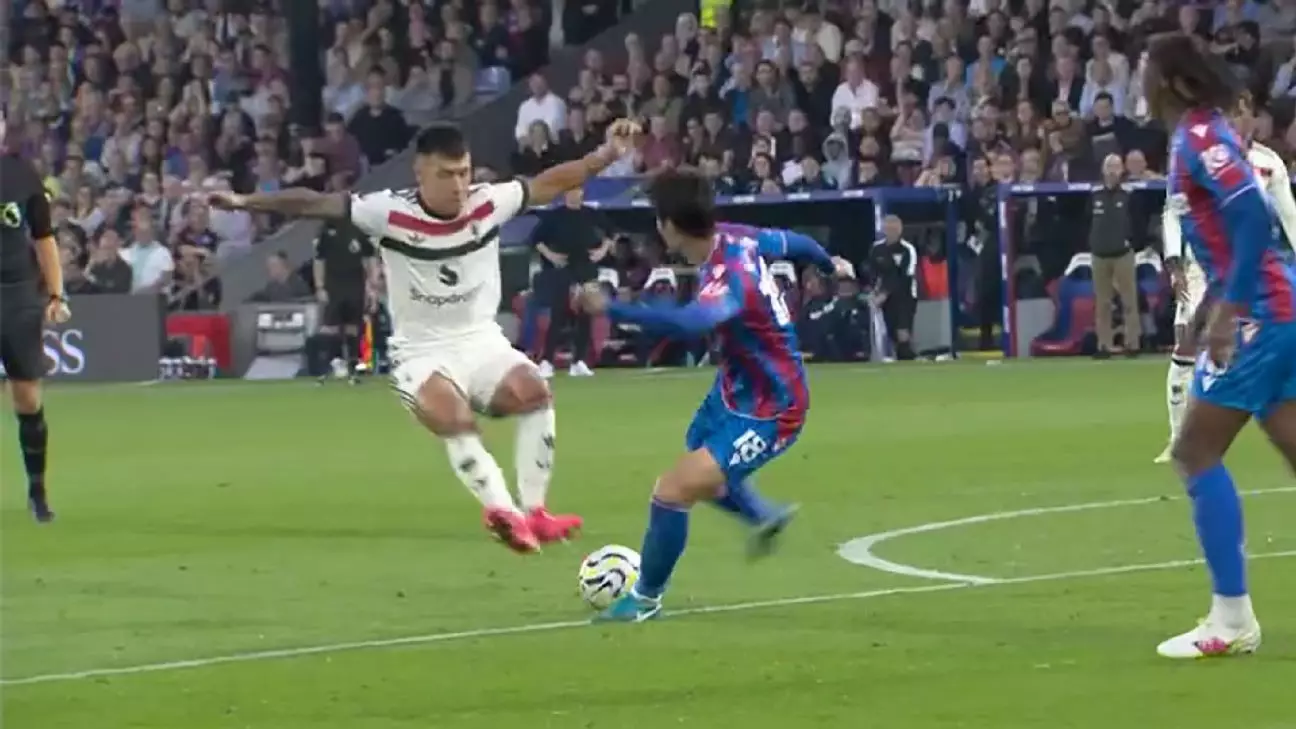The introduction of the Video Assistant Referee (VAR) system in the Premier League has ignited fervent discussions among fans, players, and analysts alike. While the primary goal of VAR is to enhance officiating accuracy and ensure fair play, its implementation has been far from seamless. Each week, pivotal moments lead to contentious debates regarding the correctness and clarity of VAR decisions. Analyzing these incidents can unveil the complexities of the decision-making process and the impact of the Laws of the Game on critical matches.
A recent match between Manchester United and Crystal Palace spotlighted a troubling incident involving United defender Lisandro Martínez in the 63rd minute. As the ball circulated around the edge of the area, a challenge ensued where Martínez appeared to engage with two feet. Referee David Coote ultimately issued a yellow card, while the VAR, Chris Kavanagh, opted not to overturn this decision for a red card. The core of the controversy centers on whether Martínez’s two-footed approach constituted a reckless tackle.
Within the context of the Laws of the Game, a tackle that endangers an opponent can warrant a red card, irrespective of whether contact is made. Critics argue that Martínez’s challenge was clearly dangerous, as it introduced a risk of injury to the Crystal Palace player, Daichi Kamada. Past incidents, such as Luton Town’s Jacob Brown escaping punishment for a similar tackle, bring further scrutiny to how consistent and fair VAR’s assessments are. The prevailing sentiment among many within the football community is that the process requires greater uniformity and clarity in its evaluative standards.
In another instance involving Manchester United, a free kick delivery ignited debate regarding potential handball infractions. The ball flicked off Palace players Maxence Lacroix and Jefferson Lerma, both initially evoking calls for a penalization. The VAR assessed the situation, but ultimately deemed there was no penalty. This illustrates how interpretations of handball and player positioning can heavily influence outcomes.
The current approach is to ensure that handball must be “blatant” for penalties to be awarded, in a shift towards a more lenient application of the handball rules. While some may support this trend toward greater leniency, it does raise concerns about the inconsistency of what constitutes “blatant.” As football evolves, are we leaning too much toward a subjective interpretation that could compromise the essence of fair play?
The complexity of goalkeeper-related incidents showcases another layer of complication for VAR. During Arsenal’s match against Manchester City, a potential foul on goalkeeper Ederson during a corner kick raised eyebrows. Although VAR ultimately allowed the goal, many have questioned the methodology behind evaluating the goalkeeper’s right to a clear run.
The dilemma hinges on whether players can legally impede a goalkeeper without constituting a foul. Consistent interpretations seem lacking here—while contact is often unavoidable during set pieces, the threshold for what is considered acceptable interaction remains ambiguous. As seen in previous matches involving Tottenham’s Guglielmo Vicario, such situations are subjective and can potentially shape the matches significantly.
Beyond moments of pitch play, VAR also faces criticism regarding its handling of post-match disciplinary actions. The incident involving Manchester City’s Erling Haaland, who threw the ball at Gabriel following a goal, raised questions about violent conduct and the threshold for VAR intervention. While such actions may seem minor in the grand scheme, they reflect a deeper issue regarding how VAR assesses aggression and hostility.
In this case, VAR dismissed the incident as petulance rather than a serious offense. This response raises eyebrows about the officials’ willingness to penalize minor yet unsportsmanlike conduct. A consistency in penalization is imperative to maintain the integrity of the game, and overlooking such infractions could set unwelcome precedents.
As VAR continues to navigate the intricacies of English football, the demand for clarity and consistency has never been louder. Each match brings fresh controversies that underscore the need for a refined and transparent protocol aimed at providing fair assessments. Whether it’s evaluating serious foul play or handball appeals, the governing bodies of football must strive to streamline VAR practices to foster a sense of trust and reliability among players, officials, and fans alike.
Ultimately, the evolution of VAR for better officiating in the Premier League must encompass a collective commitment to understanding and adhering to the Laws of the Game. Only then can the beautiful game regain its fluidity while ensuring fairness and justice on the pitch.

